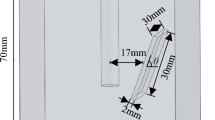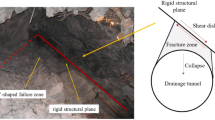Abstract
Rock sections in intermittent joints are important structures that prevent joints from interconnecting and maintain the stability of the rock mass, and they play a pivotal role in the strength and failure mode of the rock mass. In order to analyze the controlling effect of rock section in intermittent joints, the samples with different rock section angles were prepared and laboratory tests were carried out using Acoustic Emission and Digital Image Correlation (DIC) techniques. The results show that the uniaxial compressive strength of the samples reaches its minimum value when the orientation of the rock section in the intermittent joints coincides with the loading direction. Furthermore, as the angle of the rock section increases, the time share of the sample in the compaction stage increases and the time share in the plastic-yield stage decreases. The samples show the structural characteristics of being difficult to close at the early stage and easy to destroy at the late stage. In terms of the damage mode, the increase in the angle of the rock section reduces the difficulty of the rock section itself being penetrated, and the samples are more easily damaged. Finally, a damage constitutive model considering the compaction stage and initial damage was developed and the effect of rock section angle on the rate of rock damage was analyzed.
Highlights
-
The influence of the angle of the rock section in the intermittent joints on the compressive strength and failure mode of the samples was investigated.
-
Based on acoustic emission, DIC and damage constitutive models, the effect of the angle of the rock section in an intermittent joint on the deformation phase of the sample is quantified.
-
A damage constitutive model considering the initial damage of the intermittent joints and the compaction stage of the rock is proposed.


















Similar content being viewed by others
Data Availability
The data used to support the findings of this study are available from the corresponding author upon request.
References
Aziznejad S, Esmaieli K, Hadjigeorgiou J, Labrie D (2018) Responses of jointed rock masses subjected to impact loading. J Rock Mech Geotechn Eng 10(4):624–634. https://doi.org/10.1016/j.jrmge.2017.12.006
Bandis SC, Lumsden AC, Barton NR (1983) Fundamentals of rock joint deformation. Int J Rock Mech and Min 20(6):249–268
Cao RH, Cao P, Fan X, Xiong XG, Lin H (2016) An experimental and numerical study on mechanical behavior of ubiquitous-joint brittle rock-like specimens under uniaxial compression. Rock Mech Rock Eng 49(11):4319–4338. https://doi.org/10.1007/s00603-016-1029-6
Chen GQ, Liu H, Qin CA, Zhao C, Huang RQ (2017) Mechanical properties and crack model of central rock bridge in triaxial unloading test. Chin J Rock Mech Eng. https://doi.org/10.13722/j.cnki.jrme.2016.1232
Chen S, Qiao CS, Ye Q, Khan MU (2018) Comparative study on three-dimensional statistical damage constitutive modified model of rock based on power function and Weibull distribution. Environ Earth Sci 77(3):1–8. https://doi.org/10.1007/s12665-018-7297-6
Delonca A, Gunzburger Y, Verdel T (2021) Cascade effect of rock bridge failure in planar rock slides: numerical test with a distinct element code. Nat Hazards Earth Syst Sci 21(4):1263–1278. https://doi.org/10.5194/nhess-21-1263-2021
Gao G, Yao W, Xia K, Li Z (2015) Investigation of the rate dependence of fracture propagation in rocks using digital image correlation (DIC) method. Eng Fract Mech 138:146–155. https://doi.org/10.1016/j.engfracmech.2015.02.021
Huang RQ, Huang D (2014) Evolution of rock cracks under unloading condition. Rock Mech Rock Eng 47(2):453–466. https://doi.org/10.1007/s00603-013-0429-0
Lemaitre J (1985) A continuous damage mechanics model for ductile fracture. Trans Asme J Eng Mater Technol 107(107):83–89
Liu XS, Ning JG, Tan YL, Gu QH (2016) Damage constitutive model based on energy dissipation for intact rock subjected to cyclic loading. Int J Rock Mech Min Sci 85:27–32. https://doi.org/10.1016/j.ijrmms.2016.03.003
Liu XL, Han MS, He W, Li XB, Chen DL (2020) A new b value estimation method in rock acoustic emission testing. J Geophys Res Solid Earth 125(12):1–21. https://doi.org/10.1029/2020jb019658
Lv H, Peng K, Shang XY, Wang YQ, Liu ZP (2022) Experimental research on the mechanical and acoustic emission properties of sandstone tensile failure. Theor Appl Fract Mech 118:1–13. https://doi.org/10.1016/j.tafmec.2021.103225
Ohno K, Ohtsu M (2010) Crack classification in concrete based on acoustic emission. Constr Build Mater 24(12):2339–2346. https://doi.org/10.1016/j.conbuildmat.2010.05.004
Plesha ME (2010) Constitutive models for rock discontinuities with dilatancy and surface degradation. Int J Numer Anal Meth Geomech 11(4):345–362
Rao M, Lakshmi KJP (2005) Analysis of b-value and improved b-value of acoustic emissions accompanying rock fracture. Curr Sci 89(9):1577–1582
Saeb S (1992) Modelling rock joints under shear and normal loading. Intjrock Mechminsci Geomechabstr 29(3):267–278
Shang J, Zhao Z, Hu J, Handley K (2018) 3D particle-based DEM investigation into the shear behaviour of incipient rock joints with various geometries of rock bridges. Rock Mech Rock Eng 51(11):3563–3584. https://doi.org/10.1007/s00603-018-1531-0
Tran DT, Shimada N, Lee JH (2022) Triple-sigmoid activation function for deep open-set recognition. Ieee Access 10:77668–77678. https://doi.org/10.1109/access.2022.3192621
Wang JG, Ichikawa Y, Leung CF (2003) A constitutive model for rock interfaces and joints. Int J Rock Mech Min Sci 40(1):41–53
Wang J, Song Z, Zhao B, Liu X, Liu J, Lai J (2018) A study on the mechanical behavior and statistical damage constitutive model of sandstone. Arab J Sci Eng 43(10):5179–5192. https://doi.org/10.1007/s13369-017-3016-y
Wang Y, Meng HJ, Long DY (2021) Experimental investigation of fatigue crack propagation in interbedded marble under multilevel cyclic uniaxial compressive loads. Fatigue Fract Eng Mater Struct 44(4):933–951. https://doi.org/10.1111/ffe.13404
Wu Y, Zhao Y, Tang P, Wang W, Jiang L (2022) Analysis of the mechanical properties and failure modes of rock masses with nonpersistent joint networks. Geomech Eng 30(3):281–291. https://doi.org/10.12989/gae.2022.30.3.281
Xie SJ, Lin H, Wang YX, Cao RH, Yong R, Du SG, Li JT (2020) Nonlinear shear constitutive model for peak shear-type joints based on improved Harris damage function. Arch Civil Mech Eng. https://doi.org/10.1007/s43452-020-00097-z
Xie F, Xing HZ, Wang MY (2022) Evaluation of processing parameters in high-speed digital image correlation for strain measurement in rock testing. Rock Mech Rock Eng 55(4):2205–2220. https://doi.org/10.1007/s00603-021-02769-5
Yang H, Duan HF, Zhu JB (2020a) Effects of filling fluid type and composition and joint orientation on acoustic wave propagation across individual fluid-filled rock joints. Int J Rock Mech Min Sci. https://doi.org/10.1016/j.ijrmms.2020.104248
Yang YT, Xu DD, Liu F, Zheng H (2020b) Modeling the entire progressive failure process of rock slopes using a strength-based criterion. Comput Geotech 126:1–12. https://doi.org/10.1016/j.compgeo.2020.103726
Yang B, Qin S, Xue L, Chen H (2021) The reasonable range limit of the shape parameter in the Weibull distribution for describing the brittle failure behavior of rocks. Rock Mech Rock Eng 54(6):3359–3367. https://doi.org/10.1007/s00603-021-02414-1
Zhang K, Li N, Liu WL, Xie JB (2020) Experimental study of the mechanical, energy conversion and frictional heating characteristics of locking sections. Eng Fract Mech 228:1–21. https://doi.org/10.1016/j.engfracmech.2020.106905
Zhang S, Lin H, Chen Y, Wang Y, Zhao Y (2022) Acoustic emission and failure characteristics of cracked rock under freezing-thawing and shearing. Theor Appl Fract Mech 121:103537. https://doi.org/10.1016/j.tafmec.2022.103537
Zhao K, Ma HL, Yang CH, Daemen JJK (2022) The role of prior creep duration on the acoustic emission characteristics of rock salt under cyclic loading. Int J Rock Mech Min Sci 157:1–12. https://doi.org/10.1016/j.ijrmms.2022.105166
Zhou JF, Chen QS, Wang JX (2017) Rigid block based lower bound limit analysis method for stability analysis of fractured rock mass considering rock bridge effects. Comput Geotech 86:173–180. https://doi.org/10.1016/j.compgeo.2017.01.016
Zhu WC, Tang CA (2004) Micromechanical model for simulating the fracture process of rock. Rock Mech Rock Eng 1:37
Acknowledgements
This paper gets its funding from Project (NRMSSHR-2022-Z08) supported by Key Laboratory of Natural Resources Monitoring and Supervision in Southern Hilly Region, Ministry of Natural Resources; Hunan provincial key research and development Program(2022SK2082); Projects (42277175, 52104110) supported by National Natural Science Foundation of China; Hunan Civil Air Defense Research Project (HNRFKJ-2021-07). The authors wish to acknowledge these supports.
Author information
Authors and Affiliations
Corresponding author
Ethics declarations
Conflict of interest
The authors declare no conflicts of interest.
Additional information
Publisher's Note
Springer Nature remains neutral with regard to jurisdictional claims in published maps and institutional affiliations.
Rights and permissions
Springer Nature or its licensor (e.g. a society or other partner) holds exclusive rights to this article under a publishing agreement with the author(s) or other rightsholder(s); author self-archiving of the accepted manuscript version of this article is solely governed by the terms of such publishing agreement and applicable law.
About this article
Cite this article
Tang, Y., Lin, H., Cao, R. et al. Role of Rock Sections in Intermittent Joints in Controlling Rock Mass Strength and Failure Modes. Rock Mech Rock Eng 56, 5203–5221 (2023). https://doi.org/10.1007/s00603-023-03320-4
Received:
Accepted:
Published:
Issue Date:
DOI: https://doi.org/10.1007/s00603-023-03320-4




